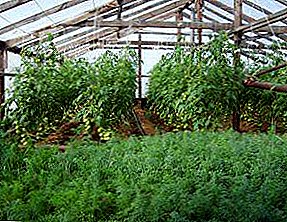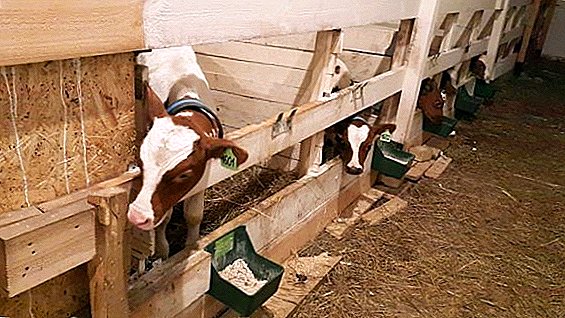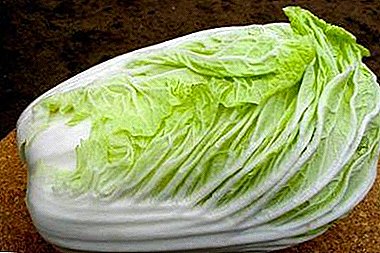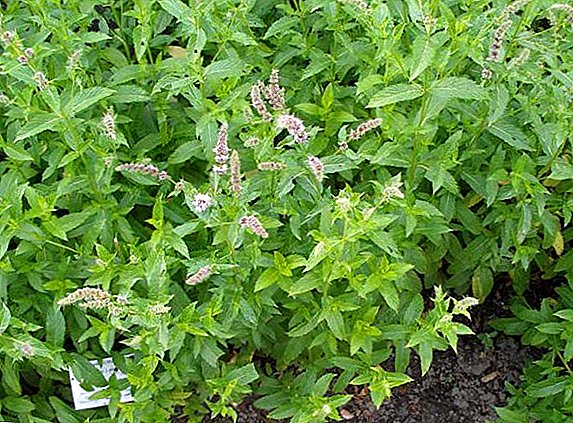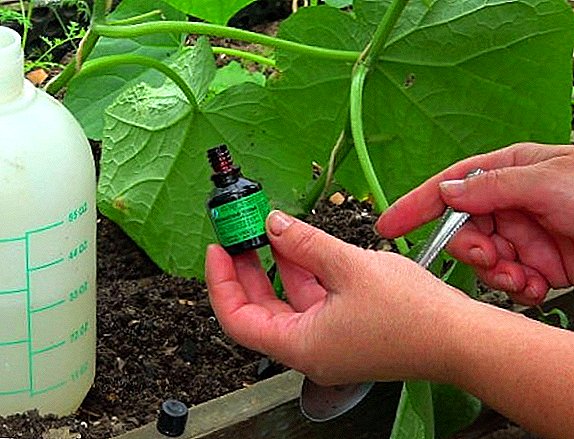 The words "tomato" and "preparation" for our compatriots are inseparable concepts.
The words "tomato" and "preparation" for our compatriots are inseparable concepts.
Even a cursory glance at the stocks stored in the basement or on the balcony is enough to notice the important place among them is given to tomatoes in the form of juice, adzhika and other gas stations.
Any housewife knows many recipes. Let us dwell on those that allow us to preserve the taste of these amazing fruits for a longer time.
Find out what are useful cherry tomatoes, green tomatoes, who and when to refrain from eating a tomato.
The easiest way to prepare: how to freeze tomatoes
This is the simplest method that allows you to store tomatoes for a long time. From the "props" you will need a knife, a doshochka, a colander, a plate and packages in which stocks will be stored.
The work itself looks like this:
- The tomatoes, washed and without tails, are cut into pieces approximately 1.5x2 cm in size. It happens that the vegetables have had time to crack, in such cases it is necessary to cut off the damaged area.
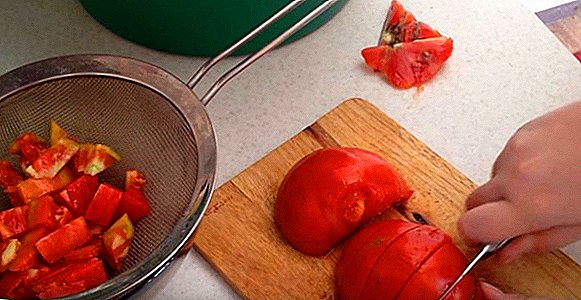
- Then the resulting pieces spread in a colander, exhibited on a plate. Wait until the slurry comes off the workpiece. If you use brainline tomatoes, you will need to remove seeds that retain fluid.

- When planning to make a sauce in the future, keep in mind that it is desirable to remove the peel from a vegetable before freezing. But the preparations for soups or pizza, it does not interfere.
- Making sure that the liquid is gone, it remains to pack the pieces into sachets (600-700 g each, 500 g - this is for a bulk freezer). More than 1 kg per package is not worth taking. Presence of air is allowed. The packed, tightly tied billet is gently shaken and placed in the freezer.
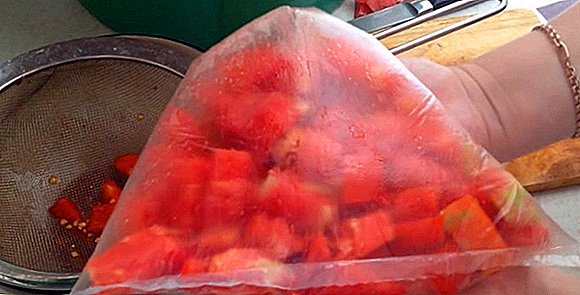
Important! Even before cutting tomatoes collected for freezing, wipe dry.This ingredient can be added directly to dishes, without prior defrosting.
Learn more about tomato freezing.
Marinated tomatoes for the winter
Probably, the hostess, who at least once did not pickle tomatoes, is unlikely to be found. This popularity is largely due to ease of preparation. 
Required Ingredients
In addition to tomatoes, a 3-liter jar will require:
- pepper-peas;
- greenery;
- Bay leaf;
- round white mustard (1/2 tsp);
- 2-3 large cloves of garlic;
- sugar (6 tbsp. l.);
- salt (2 tbsp. l.);
- apple cider vinegar 6% (20 ml).
Step by Step Cooking Process
First of all, the container and the lid are treated with boiling water and dried. Further actions will be as follows:
- 4-6 peas of pepper and dry mustard are put into the jar.
- Do not forget about the bay leaf, as well as garlic (whole cloves). Additional spices are added at this stage.

- Then dill and parsley are sent to the jar (as an option, basil or horseradish, but this is a matter of taste).
- Now it's the turn of tomatoes. They must be clean, without visible damage. They lay more tightly.

- Then clean water is poured.
- Taking a bowl under the marinade itself, put a "drain" lid with holes on the jar or simply drain the liquid, holding the usual lid.

- Sugar and salt are poured into the brine, after which the bowl is covered with a lid and put on a small fire.
- Bringing the brine to a boil, remove it from the stove and add vinegar. Ideally, they take an apple (it retains the taste well and gives it subtle notes). If it was not at hand - it does not matter: the usual 9% will fit, but in a volume of 40 ml.
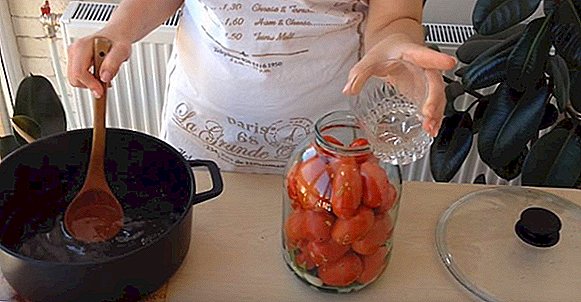
- The brine is poured into the jar, which is immediately covered and set aside for 20-30 minutes (until it cools).
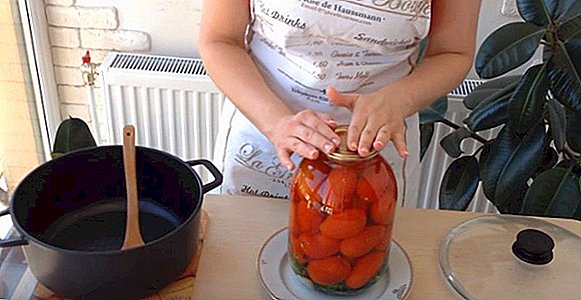
Did you know? In the homeland of tomato, in South America, you can still see arrays of wild tomatoes, often annoying local farmers.In the final roll cover, and the jar tightly wrapped in a blanket, where it will be until it cools completely.
It's simple, but in such a simple technology there is one thing that causes frequent discussions. It's about the sterilization of jars filled with brine. Usually this manipulation is passed, and even with large volumes of tomatoes it takes a lot of time. In addition, because of the presence of vinegar, there is no particular need for it. Those who still decided to master this technique need to act in this order:
- A container filled with brine is placed in a high saucepan, at the bottom of which two clean rags are laid, barely covered with hot water.

- Then boiling water is added (to the level of half the height of the jar).
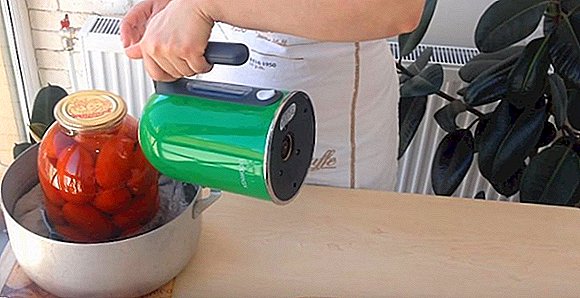
- The saucepan is placed on the stove and the water in it is brought to a boil. 10 minutes of boiling, and can be removed. By this time, the brine will become very hot, and upward bubbles will be clearly visible in the jar. You can shoot and roll.

Important! To give the pickled tomatoes a more subtle taste, several washed grape or currant leaves are added to the jar during harvesting. In this regard, cherry leaf is not bad.In general, this part of the work, as they say, “is an amateur”, although to many the taste of tomatoes that have undergone similar processing seems more piquant.
Learn how to pickle, sour, pickle green tomatoes.
Tomato and Pepper Salad
In the winter cold, we usually remember the summer with its warmth, holidays and, of course, the gifts of nature as a harvest. This is exactly the kind of gastronomic "greetings" from the hot pores. 
Required Ingredients
- Tomatoes - 1 kg;
- Bulgarian pepper, carrots and onions - 300 g each;
- garlic - 3 cloves;
- dill and parsley - 1 bunch;
- sugar - 2 tbsp. l with a hill;
- salt - 2 tbsp. l., but without a slide;
- vegetable oil - 70 ml;
- Vinegar 9% - 2 tbsp. l .;
- red pepper - ¼ tsp.
Step by step process with photos
It all starts with slicing tomatoes in medium slices. Be sure to remove the hard stem. Then proceed to other procedures:
Then proceed to other procedures:
- Sweet peppers are cut into strips, and onions are cut into half rings.

- Garlic is ground on a fine grater, and carrot - on a large one.

- Then cut the greens, and the whole vegetable preparation is placed in a saucepan.

- She is covered with salt, sugar and red pepper, without forgetting about vegetable oil.
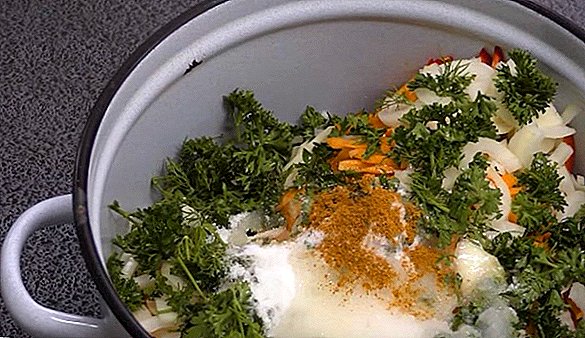
- Thoroughly mixing all the ingredients, the container for 1 hour set aside - this is enough to marinate the vegetables.

- Then you need to bring the salad to a boil by adding vinegar. In this brine, the billet will be stewed for 2-3 minutes.
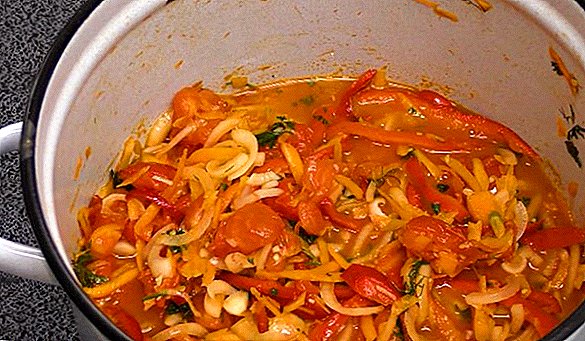
- After removing the container from the heat, the hot salad is laid out in sterile jars, which are immediately rolled up. At the time of cooling they turn over, putting on the cover, and wrap a blanket.
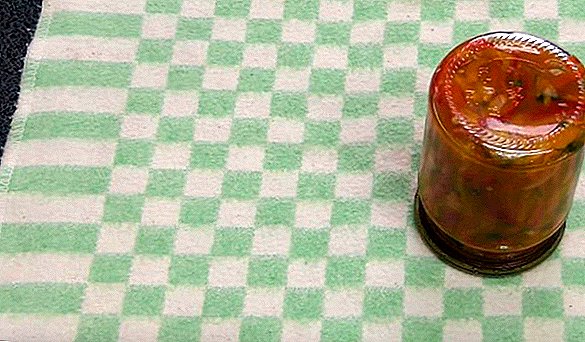
Did you know? Tomatoes contain serotonin (it is also the hormone of happiness).As you can see, there are no tricks, and the taste of such a salad will surely please many.
Learn how to make tomato jam, tomatoes with mustard, pickled tomatoes with onions, salted, pickled, in own juice, dried tomatoes, tomato salads.
Adzhika preparation
Well, where do without almost all your favorite adzhiki. For those who have not encountered its preparation, it often seems like a rather complicated process. In fact, everything is much easier.
Grocery list
- Tomatoes - 5 kg.
- Sweet pepper (red and yellow) - 1.8 kg.
- Onions, garlic and hot pepper - 150 g.
- Vegetable oil - 0.5 liters.
- Salt to taste.
Cooking process
Before processing, washed tomatoes should be cut into small pieces, and the pepper should be cut into two halves. Getting Started:
- The main ingredients are ground in a meat grinder. The first tomatoes are passed through it, then go sweet and hot peppers, and only then onions.

- The mass that has entered the pan is thoroughly mixed, after which the container is placed on medium heat (for 3 hours). An hour later, you can see that the workpiece will decrease in volume, and after 2 it will almost reach the state of porridge. Be sure to stir the adjika so that it does not burn.

- Fifteen minutes before the end, the garlic is crushed into mush and added to the billet, once again thoroughly mixing it.
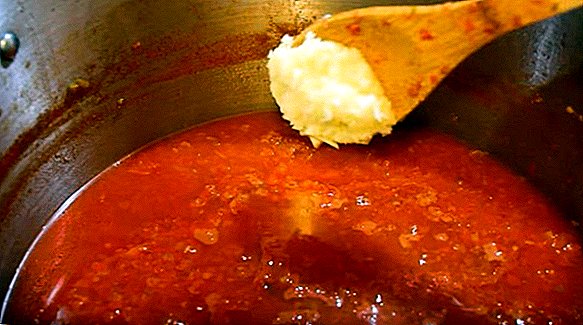
- Then add salt (be guided by the taste) and vegetable oil. We interfere and give to boil the whole composition.
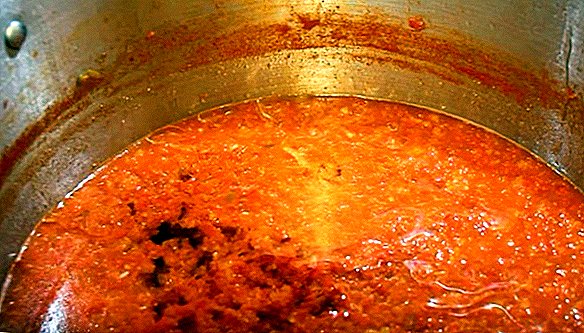
- While adjika comes to readiness, we will prepare the container. Banks are washed and dried, and the lids are kept in boiling water.
- Adjika taken from the stove is immediately placed in jars and rolled up. Additional sterilization is not required here, and the stocks are simply wrapped in a blanket, leaving it to cool completely.

Important! Red pepper in the recipe adjiki is increasingly replaced by jalapeno (this is one of the varieties of chili). But because of its very pungent taste, it is added in somewhat smaller quantities.Thus obtained "seaming" will be an excellent dressing for the first dishes and a good side dish. It is possible and simpler, spreading a piece of bread with adzhika. Taste unmatched - a real summer treat in the middle of winter.
Learn how else you can cook adjika.
Sliced tomatoes for the winter
Another traditional recipe for tomato blanks - preservation slices. Even such a simple product can please with its piquant flavor. We learn how to achieve this effect.
Grocery list
Per liter jar you need to take:
- medium-sized cream tomatoes;
- 0.5 liters of water;
- 50 grams of sugar;
- 4 peppercorns;
- 2 bay leaves;
- 1 tbsp. vegetable oil;
- on ½ tbsp. l salt and 9% vinegar;
- just a little mustard (literally at the tip of the knife).
Step-by-step process
Getting started:
- Spices (pepper, bay leaf and mustard) are laid on the bottom of the jar.
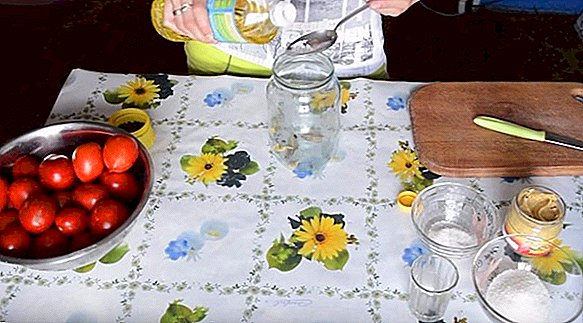
- Only after this is added vegetable oil.
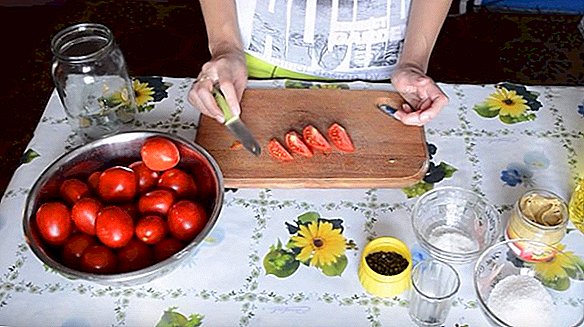
- Tomatoes are cut into four parts. The stem is naturally removed. The lobules are tightly placed in a jar, filling it to the top.

- The line for brine. In 0.5 l of warm water, add salt and sugar, and put the saucepan on a slow fire. Bring to a boil, drip vinegar. Capacity is removed.

- Filling the jars with hot pickle and covering them with lids is immediately sterilized (this process is described a little higher).
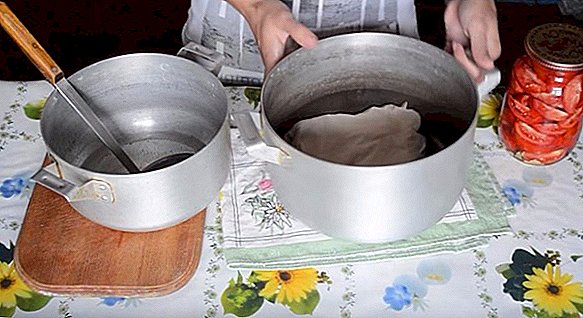
- In the final part, it all comes down to the usual procedures: rolling and cooling.
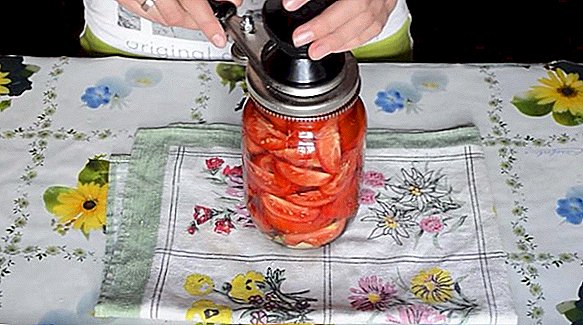
Did you know? The first tomatoes were brought to Europe by Columbus himself (it was in 1498). But these fruits were recognized as edible only two centuries later - the earliest of the written recipes with their participation is dated 1698.It is easy to work with sliced lobules, but they have a clear advantage - such blanks preserve their taste qualities longer.
Learn how to prepare peppers, cucumbers, eggplants, cabbage, zucchini, squash, mushrooms, mushrooms, chanterelles, mushrooms, apples, onions, arugula, green peas, green bean for the winter.
Tomato juice for the winter
"Twist" tomatoes on the juice. Perhaps this is one of the most vivid memories of summer and a great way to recycle an impressive crop of tomatoes with benefit. Facilitate this procedure will help the following recipe.
Required Ingredients
Specifically, in this case, need only tomatoes. Additives in the form of salt, vinegar or sugar is not here.
Step by Step Cooking Process
In general, the algorithm is familiar to all. Consider it again, paying attention to the nuances:
- Washed tomatoes are cut into fractions, which will effortlessly pass into a meat grinder. The stem remains (it will still spin out).

- During processing spin may contain a lot of pulp. To "dry" it, this mass is re-passed through the auger. And the grains in the juice gets much less.
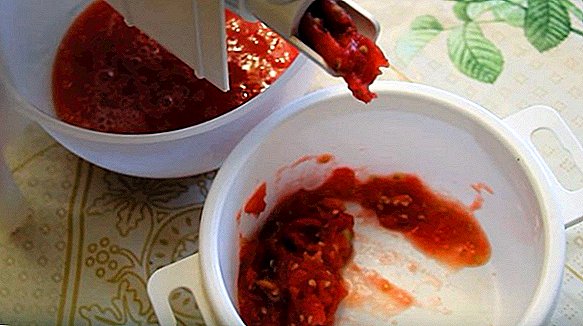
- Pot with fresh juice put on the stove and, stirring occasionally, bring to a boil. Boil for 5 minutes, not forgetting to remove the thickest foam. Small noise is simply dispersed, thoroughly mixing the juice.

- After that, a small fire is set, and the juice is immediately poured into sterile jars, immediately rolling them up.
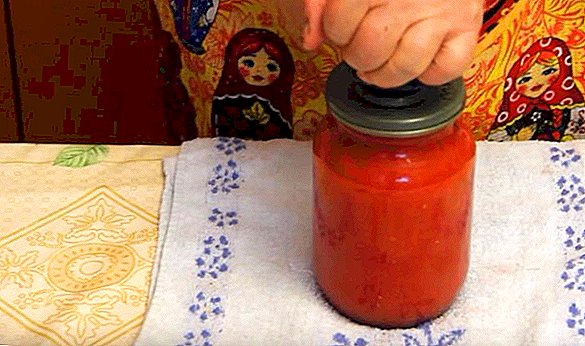
- Fill the sealed container overturned and put on the cover, wrapped. Everything remains to wait until the stocks cool down.
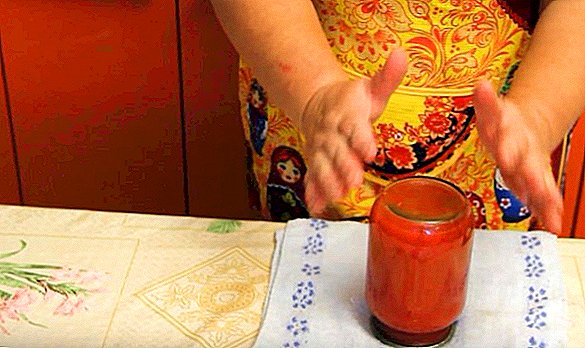
Important! When working with large volumes of juice, make sure that dust or small insects do not enter there (which is not uncommon when processing tomato outdoors).The "pure" juice obtained in this way is ideal for making lecho, zucchini or fresh tomato additives (tomatoes are produced in its own juice). Moreover, banks with a similar twist will not explode even with a brief violation of storage conditions.
Learn how to harvest strawberries, raspberries, cherries, plums, apples, gooseberries, watermelon, red, black currants, melons, cherries, cranberries, yoshtu, mountain ash, sunberry, physalis, blueberries for the winter.
The basic rules for storage of blanks of tomatoes
Like any product harvested for the winter, tomatoes are very sensitive to their content. In order for them to keep their taste longer, you need to remember a few subtleties:
- Tightness. The can is rolled tight, air entering inside is excluded (at best, it slightly spoils the taste, but usually it comes to the appearance of a dangerous mold).
- Temperature mode. Capacities with juice can be stored at room temperature, but fermented tomatoes are kept only in the basement or in the refrigerator. Keep in mind that blanks with small doses of sugar or salt freeze already at -3.
- Humiditywhich, when stored in a damp basement, sometimes results in a loss of inventory. Usually, its excess is caused by the violation of waterproofing (in other words, the top and walls flow). But there is another reason, namely, the storage in the room too much fruit and vegetables. Tomatoes do not like so dense "settling".
- Shelf life. It is believed that homemade spins have an unlimited shelf life. Although, in fact, the optimal period is a year, maximum one and a half.
- Capacities and covers. The best option - the usual glass jar and tin lid. When buying lids, evaluate their integrity (there should be no deep scratches and, of course, dents).

Did you know? In our latitudes, tomatoes took root in the XVIII century, and the first decades they were grown as a purely decorative form: the fruits simply did not ripen without proper care.On top of that, it would be good to periodically inspect stocks for safety of the container and the absence of traces of fermentation.
These simple ways can quickly and without much effort to provide seven stocks of tomatoes. These recipes will help to diversify your winter menu. Have more tasty and bright moments every day!






































